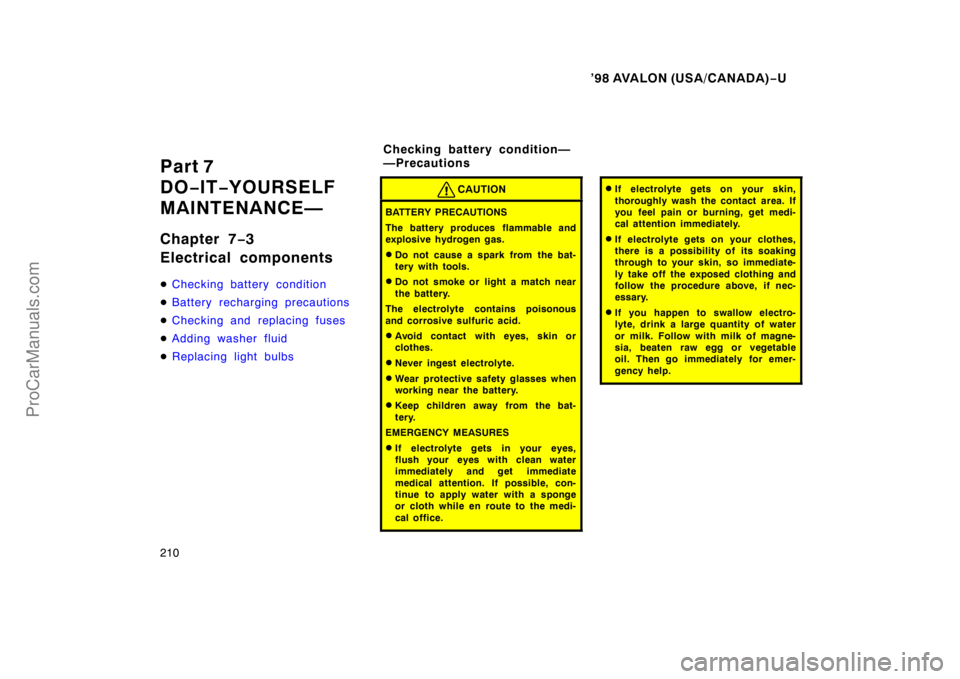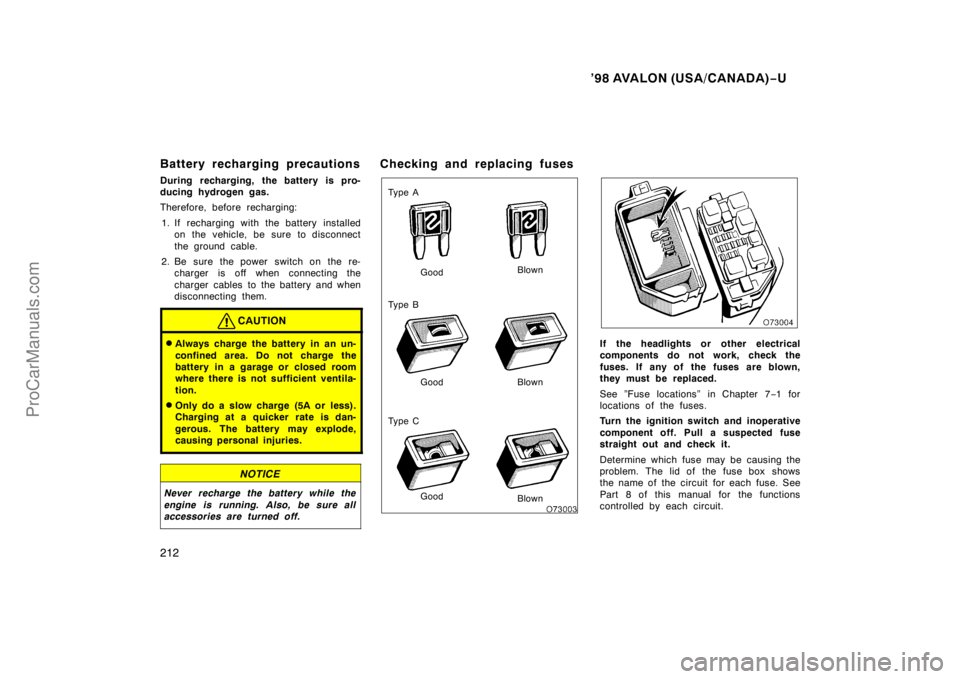Page 207 of 233

’98 AVALON (USA/CANADA)−U
207
If wheel covers are used, they will be
scratched by the chain band, so remove
the covers before putting on the chains.
CAUTION
�Do not exceed 50 km/h (30 mph) or
the chain manufacturer ’s recom-
mended speed limit, whichever is
lower.
�Drive carefully avoiding bumps,
holes, and sharp turns, which may
cause the vehicle to bounce.
�Avoid sharp turns or locked− wheel
braking, as use of chains may ad-
versely affect vehicle handling.
Replacing wheels
WHEN TO REPLACE YOUR WHEELS
If you have wheel damage such as
bending, cracks or heavy corrosion, the
wheel should be replaced.
If you fail to replace damaged wheels, the
tire may slip off the wheel or they may
cause loss of handling control.
WHEEL SELECTION
When replacing wheels, care should be
taken to ensure that the wheels are re-
placed by ones with the same load ca-
pacity, diameter, rim width, and offset.
Correct replacement wheels are available
at your Toyota dealer.
A wheel of a different size or type may
adversely affect handling, wheel and bear-
ing life, brake cooling, speedometer/odom-
eter calibration, stopping ability, headlight
aim, bumper height, vehicle ground clear-
ance, and tire or snow chain clearance to
the body and chassis. Replacement with used wheels is not rec-
ommended as they may have been sub-
jected to rough treatment or high mileage
and could fail without warning. Also, bent
wheels which have been straightened may
have structural damage and therefore
should not be used. Never use an inner
tube in a leaking wheel which is designed
for a tubeless tire.
ProCarManuals.com
Page 210 of 233

’98 AVALON (USA/CANADA)−U
210
Part 7
DO −IT −YOURSELF
MAINTENANCE—
Chapter 7 −3
Electrical components
� Checking battery condition
� Battery recharging precautions
� Checking and replacing fuses
� Adding washer fluid
� Replacing light bulbs
CAUTION
BATTERY PRECAUTIONS
The battery produces flammable and
explosive hydrogen gas.
�Do not cause a spark from the bat-
tery with tools.
�Do not smoke or light a match near
the battery.
The electrolyte contains poisonous
and corrosive sulfuric acid.
�Avoid contact with eyes, skin or
clothes.
�Never ingest electrolyte.
�Wear protective safety glasses when
working near the battery.
�Keep children away from the bat-
tery.
EMERGENCY MEASURES
�If electrolyte gets in your eyes,
flush your eyes with clean water
immediately and get immediate
medical attention. If possible, con-
tinue to apply water with a sponge
or cloth while en route to the medi-
cal office.
�If electrolyte gets on your skin,
thoroughly wash the contact area. If
you feel pain or burning, get medi-
cal attention immediately.
�If electrolyte gets on your clothes,
there is a possibility of its soaking
through to your skin, so immediate-
ly take off the exposed clothing and
follow the procedure above, if nec-
essary.
�If you happen to swallow electro-
lyte, drink a large quantity of water
or milk. Follow with milk of magne-
sia, beaten raw egg or vegetable
oil. Then go immediately for emer-
gency help.
Checking battery c ondition—
—Precautions
ProCarManuals.com
Page 211 of 233

’98 AVALON (USA/CANADA)−U
211
—Checking battery exterior
Terminals
Ground cable
Hold −down
clamp
Check the battery for corroded or loose
terminal connections, cracks, or loose
hold −down clamp.
a. If the battery is corroded, wash it off with a solution of warm water and bak-
ing soda. Coat the outside of the termi-
nals with grease to prevent further cor-
rosion.
b. If the terminal connections are loose, tighten their clamp nuts—but do not
overtighten.
c. Tighten the hold −down clamp only
enough to keep the battery firmly in
place. Overtightening may damage the
battery case.
NOTICE
� Be sure the engine and all accesso-
ries are off before performing main-
tenance.
� When checking the battery, remove
the ground cable from the negative
terminal (”—” mark) first and rein-
stall it last.
� Be careful not to cause a short cir-
cuit with tools.
� Take care no solution gets into the
battery when washing it.
—Checking battery fluid
Ty p e A
Green Dark Clear or
light yellow
Ty p e B Blue White Red
CHECKING BY THE HYDROMETER
Check the battery condition by the
hydrometer color.
Hydrometer colorConditionTy p e ATy p e B
GREENBLUEGood
DARKWHITECharging necessary. Have
battery checked by your
Toyota dealer.
CLEAR or
LIGHT
YELLOWREDHave battery checked by
your Toyota dealer.
ProCarManuals.com
Page 212 of 233

’98 AVALON (USA/CANADA)−U
212
Battery recharging precautions
During recharging, the battery is pro-
ducing hydrogen gas.
Therefore, before recharging:
1. If recharging with the battery installed on the vehicle, be sure to disconnect
the ground cable.
2. Be sure the power switch on the re- charger is off when connecting the
charger cables to the battery and when
disconnecting them.
CAUTION
�Always charge the battery in an un-
confined area. Do not charge the
battery in a garage or closed room
where there is not sufficient ventila-
tion.
�Only do a slow charge (5A or less).
Charging at a quicker rate is dan-
gerous. The battery may explode,
causing personal injuries.
NOTICE
Never recharge the battery while the
engine is running. Also, be sure all
accessories are turned off.
Checking and replacing fuses
Ty p e A
Ty p e B
Ty p e C Good
Blown
Good Blown
Blown
Good
If the headlights or other electrical
components do not work, check the
fuses. If any of the fuses are blown,
they must be replaced.
See ”Fuse locations” in Chapter 7
−1 for
locations of the fuses.
Turn the ignition switch and inoperative
component off. Pull a suspected fuse
straight out and check it.
Determine which fuse may be causing the
problem. The lid of the fuse box shows
the name of the circuit for each fuse. See
Part 8 of this manual for the functions
controlled by each circuit.
ProCarManuals.com
Page 214 of 233

’98 AVALON (USA/CANADA)−U
214
Replacing light bulbs—
The following illustrations show how to
gain access to the bulbs. When replacing
a bulb, make sure the ignition switch and
light switch are off. Use bulbs with the
wattage ratings given in the table.
CAUTION
Halogen bulbs have pressurized gas
inside and require special handling.
They can burst or shatter if scratched
or dropped. Hold a bulb only by its
plastic or metal case. Do not touch
the glass part of a bulb with bare
hands.
NOTICE
Only use a bulb of the listed type.
Light bulbsBulb
No.WTy p e
Headlights
(low beam)900651A
Headlights
(high beam)900560B
Front fog lights—55C
Parking and front turn
signaol lights3157 NA27/8E
Rear turn signal lights744021E
Stop and tail lights744321/5E
Rear side marker lights1683.8E
Back −up lights92118E
License plate lights1685E
High mounted
stop light92118E
Interior light—8F
Front personal lights—8D
Rear personal lights—8D
Glovebox light—1.2E
Door courtesy lights1945E
Trunk light—3F
A: HB4 halogen bulbs
B: HB3 halogen bulbs
C: H3 halogen bulbs
D: Single end bulbs
E: Wedge base bulbs
F: Double end bulbs
—Headlights
1. Unplug the connector while depress-
ing the lock release.
If the connector is tight, wiggle it.
ProCarManuals.com
Page 215 of 233
’98 AVALON (USA/CANADA)−U
215
2. Turn the bulb and remove it.3. Install a new bulb and the connector
into the mounting hole.
Aiming is not necessary after replacing
the bulb. When aiming adjustment is nec-
essary, contact your Toyota dealer.
—Front fog lights
1. Remove the bolts and clips, take out the engine under cover.
Remove and install the cover clips as shown
in the following illustration.
ProCarManuals.com
Page 217 of 233
’98 AVALON (USA/CANADA)−U
217
4. Release the bulb retaining spring
and remove the bulb. Install a new
bulb and the bulb retaining spring.
To install the bulb, align the cutouts of the
bulb with the protrusions of the mounting
hole.
5. Connect the cords and install thecover by turning it clockwise.
Install the engine under cover securely.
Use a Phillips −head screwdriver.
—Parking and front turn
signal lights
ProCarManuals.com
Page 218 of 233
’98 AVALON (USA/CANADA)−U
218
a: Rear turn signal light
b: Stop and tail light
c: Rear side maker light
—Rear turn signal, stop and
tail, and rear side maker
lights
ProCarManuals.com